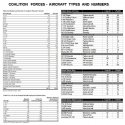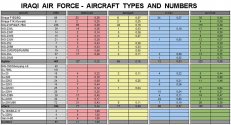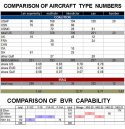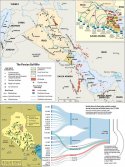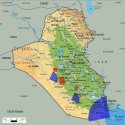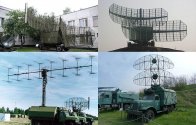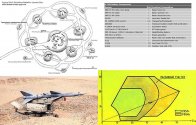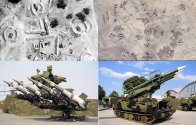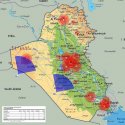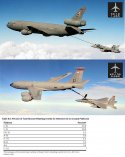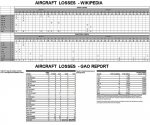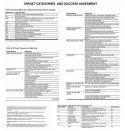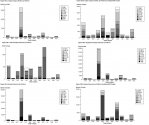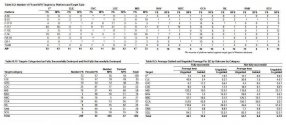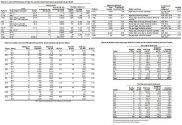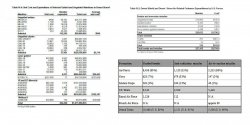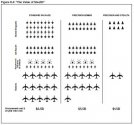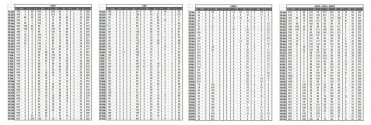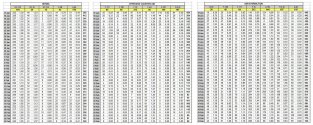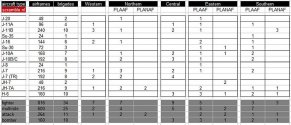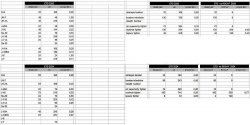Continuing - some more data on Desert Storm and speculation on how it informs a hypothetical conflict over Taiwan.
-----------------------------------------------
From Gulf War Air Power Survey "volume 5, chronology" and "volume 3, logistics & support":
Daily breakdown of missions in main categories by USAF, USN and USMC aircraft
Categories:
- AI - air interdiction
- BAI - battlefield air interdiction
- CAS - close air support
- DCA - defensive counter-air (including escort)
- CAP - combat air patrol
- OCA - offensive counter-air
- SEAD - suppression of enemy air defenses
- ESC - escort
- ESM - electronic support measures
- EW - electronic warfare
- FUEL - refueling
View attachment 78046
this image is 1600 pixels wide and requires magnification for better legibility
These tables show the intensity of operations. I excluded other coalition countries because the UK forces had activities well below those of USMC and everyone else had symbolic participation in operations inside Iraqi airspace.
Refueling events during Desert Storm:
Total refueling sorties - day average per type:
- KC-10 - 35 sorties, 240 flight hours, 222 aircraft refueled (6,34 avg.)
- KC-135 - 215 sorties, 977 flight hours, 839 aircraft refueled (3,9 avg.)
KC-10 carries 365k lbs (165t) , KC-135 carriers 200k lbs.(90t).
Refueling events and fuel by type:
- F-15 - 12 267 ref., 198,8 mn lbs.
- B-52 - 2 166 ref., 137,2 mn lbs.
- E-3 - 937 ref., 54,9 mn lbs.
- RC-135 - 739 ref., 40,7 mn lbs.
- F-16 - 14 081 ref., 88,9 mn lbs.
- F-4G - 5 061 ref., 60,6 mn lbs.
Average refueling event per type:
- B-52 63k lbs.
- E-3 58k lbs.
- RC-135 55k lbs.
- F-15 16,2k lbs.
- F-4G 12k lbs.
- F-16 6,3k lbs.
I chose six positions with
highest fuel expenditure. Other aircraft including all Navy aircraft have below 40 million. B-52s required refueling for flights from Diego Garcia. F-15s required intensive refueling for long-duration CAP missions.
Daily breakdown of missions by mission type and aircraft type
Yellow field below aircraft type shows number of aircraft deployed at the beginning of the operation. Every aircraft has two figures - the number of sorties in a given mission category and the ratio of sortie to airframe.
I included three most relevant categories for Taiwan scenario - refueling, OCA and non-battlefield interdiction because these three categories in Desert Storm had much higher numbers of participating aircraft, while other main categories - including DCA - all fit within current PLA numbers (see below):
View attachment 78047
this image is 1600 pixels wide and requires magnification for better legibility
It is interesting that with few exceptions no aircraft is (statistically) flying more than a single sortie daily and on many days they don't fly at all which suggests that the fleet wasn't used as intensively as say Israeli Air Force in during the Six-Day War even in the first day of operations. Lower overall intensity of missions explains duration of operations and low reduction in mission-capable rate (MCR) at the end of the air campaign.
Comparison of Fully Mission-Capable Rate before deployment and Desert Storm average
- RF-4C - 79,7% / 61,3%
- EF-111A - 75,8% / 47,2%
- F-16 - 90,7% / 80,8%
- F-15C - 84,6% / 78,8%
This demonstrates that specialized aircraft - recon and EW - suffer from lower readiness because their main mission equipment is not as easily replaceable as combat equipment and is also more sensitive. Interestingly EA-6B retained mission capable-rate comparable (if lower) to other USN/USMC aircraft which shows that the EF-111A's design was responsible for significant drop in readiness.
The above data should give you some impression as to what numbers on a daily basis are needed for offensive air operations against a country that is relatively comparable to Taiwan.
Now some direct comparisons:
Ratios of aircraft deployed in Desert Storm to total inventory
View attachment 78048
There is discrepancy between data provided by GAO and data from Wikipedia (also backed by the Survey) so I included both. The "all" column shows total inventory of aircraft available for all aerial formations (USAF, ANG, USN, USMC). The "proportion" column shows the share of deployed to TAI.
The most important figures to remember are: ~260 interdictor, ~420 multirole fighters and ~140 CAS aircraft which are used for attack missions in the OCA and AI categories.
PLAAF/PLANAF units per scramble (2020)
The table shows a list of brigades/regiments in each theater. The number of airframes is indicative only and is calculated by multiplying the number of units by standard 24 aircraft. Some obvious errors e.g. 240 J-11B are the consequence of this approach. The table does not include total inventory and what we know of production lots just the "active aircraft" in "active units" as listed by scramble.nl in 2020.
View attachment 78049
The above table should be used as visual aid for imagining potential deployments of units from other theaters to ETO (Eastern Theater of Operations).
Ratios of aircraft available at Eastern theater command and PLA compared to ROCAF in 2020 and hypothetical 2024 state
This comparison attempts to juxtapose available forces of both PLAAF/PLANAF and Eastern Theater Command specifically with ROCAF in a manner that follows the tables for Desert Storm. This way it is easier to imagine the share of total inventory of select types and categories of aircraft that are committed to such hypothetical operation.
2024 scenario is hypothetical and changes to aircraft numbers are not based in any thorough analysis, just whatever seemed reasonable.
View attachment 78050
Both in 2020 and 2024 the three main categories mentioned before - refueling, offensive counter-air and general air interdiction will fall short of required numbers of airframes. While the number of bombers, air-superiority fighters, EW and AEW aircraft as well as other auxiliary aircraft is sufficient (especially including temporary deployments) the key categories of interdictor and multirole/attack are low.
Simple hypothetical scenarios:
To replicate Desert Storm PLA would have to at minimum double the number of daily sorties to match ODS numbers. That however still would reflect an aerial operation which lasted for 38 days. This timeframe would not be available in the case of Taiwan save for some exceedingly unique circumstances like a major conflict in other part of the world that would absorb the US.
To reduce time by half to 19 days the number of sorties would have to increase fourfold or the number of aircraft redeployed from other regions would have to match ETO numbers to retain double rate of sorties over 19 days. Fourfold increase is theoretically possible based on Israeli experiences but it requires special training, preparation and will involve a much greater attrition rate due to equipment wear. It might be impossible to sustain such intensity over 19 days.
To reduce time of operations to 7-9 days the PLA would have to increase intensity eigh-fold which is impossible, or increase intensity fourfold while also temporarily doubling the number of aircraft (interdictor and multirole) in ETO. That seems workable but requires preparation and will have a greater impact on readiness immediately after the operation.
The above considerations assume the same attrition rate resulting from effectiveness of enemy defenses which was extremely low during Desert Storm. It may or may not be the case in a hypothetical Taiwan conflict.
None of the scenarios has sufficient number of refueling aircraft to facilitate complex aerial operations. ODS had over 220 large tankers employed for the duration of the conflict. That number was instrumental in not only facilitating optimal attack routes but maintaining effective DCA/CAP with very low numbers of fighters used as well as persistent AEW/EW cover.
In short while the current production rates make ODS-like operation possible in terms of fighter numbers the
lack of sufficient aerial refueling fleet makes it impossible logistically. Since retaining initiative (ready aircraft in the air) is more important than mere number of strikes against targets (in case of surface-launched missiles replacing some of the airstrikes) it makes any intensive aerial campaign over Taiwan logistically unfeasible until at least matching numbers of tanker aircraft are achieved. Being able to strike with little preparation and respond to a dynamic situation in the air was key to achieving and retaining advantage and then supremacy over Iraq during the campaign. That included repeated airstrikes (re-strikes) on targets classified as "not fully successful" (see earlier posts.) However even achieving required number of tankers does not solve potential complications arising from increased intensity of operations, attrition etc.
In conclusion - the available data suggests that in the next several years a Desert Storm-like aerial operation over Taiwan is not a possibility with the main constraint being the number of available aerial refueling aircraft.
